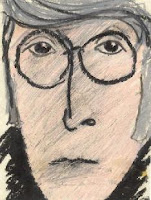
The pair of seats above was acquired at the last game played at Parker Field in 1984. With the help of my then-girlfriend, Tana, we literally ripped them up from their platform. Others were doing the same, as the authorities actually allowed/encouraged it. A few days later the grandstands were torn down. The glove is my 1976 model Nokona.
Note: With no baseball in Richmond this summer, I’ve dusted off an old piece I wrote for STYLE Weekly (published Oct. 4, 1999).
*
With the turning of the leaves, The Fan District of Richmond, Va., will again be transformed into a living impressionistic cityscape. As they always do, the season’s wistful breezes will facilitate reflection.
All of which leads to the fact that yet another baseball season has come and gone. After 6,783 games, the last game ever has been played at Detroit’s fabled Tiger Stadium. The Giants and the Astros will be playing in new parks next season as well. The World Series, first played in 1903, will soon be upon us. Although baseball’s claim as the National Pastime may no longer hold up, the colorful lore generated by the magic of events at baseball parks probably outweighs that of all the other sports put together.
Of my childhood memories few are more pleasant than those associated with attending baseball games at Parker Field. I began going to the games with my grandfather when I was about seven. Naturally, we pulled for the pinstripe-clad V’s, the home team. I eagerly drank in all I could of the atmosphere, especially the stories told about legendary players and discussions on the strategy of the game.
As I got older I began to go with my friends, most of whom played baseball. We usually took our baseball gloves with us to the game. We’d go early so we could watch the V’s warm up. As often as possible we talked with the players. If one of them remembered your name it was a source of pride.
A highlight of each spring was the day the New York Yankees came to town to play the V’s, who were part of the Yankees’ farm system. It was a geographically convenient stop for the Bronx Bombers because they were on their way North from their Florida spring training camp. Thus, this dress rehearsal game would always take place just before opening day.
Consequently, I saw Mickey Mantle, Yogi Berra, and the other great Yankees of the late ’50s and early ’60s play in Richmond.
In those days, baseball was clearly the most important thing in life to me and that meant Parker Field was like a temple. When we cheered the heroics we witnessed, and rose for the seventh inning stretch, and stayed until the last out regardless of the score, it was tantamount to exercising religious rites.
A few seasons before they tore Parker Field down (it was dismantled in 1984 and in its place stands The Diamond), I experienced one last thrill at the old ballpark. This was when my daughter, Katey, was about 7 or 8.
The home team by then — as it is now — was The Braves. Katey, her mother, and I were sitting in box seats as guests of neighbors who had gotten comps from a radio station. It was Katey’s first trip to Parker Field.
The spectacle itself was interesting to her for a while. As it was a night game, the bright lights were dazzling. The roar of the crowd was exhilarating. Being old enough to go along on such an outing, instead of staying at home with a baby sitter, was a boost to her morale. Nonetheless, by the middle of the game Katey was getting tired of sitting still and bored with baseball.
During the sixth inning it fell to me to entertain, or at least restrain her, so the others could enjoy the game. I tried telling her more about the object of baseball, hoping that would help her pay some attention to the game.
That didn’t work for very long. She was soon climbing across seats again and this time she knocked a man’s beer into his lap. As the visiting team began their turn at bat, in the top of the seventh, I got an idea and asked Katey if she wanted to see some magic. Of course she did.
Then I got her to promise to be good if I showed her a big magic trick. She agreed to the terms without qualification. Making sure she alone could hear me, I pulled her in close and whispered my instructions.
The gist of it was that she and I, using our combined powers of concentration, were going to make everyone in the ballpark stand up at the same time. Katey was thrilled at the mere prospect of such a feat. I told her to face the ongoing game, close her eyes, and begin thinking about making the crowd stand up.
After the visiting team made their third out, I cupped my hand to her ear and reminded her to think, “stand up, stand up …”
As baseball fans know, when the home team comes to bat in the bottom of the seventh inning everyone stands up, ostensibly to stretch their legs. It’s a longtime tradition called “the seventh inning stretch.” There’s a mention of the practice in a report about a Cincinnati Red Stockings (baseball’s first professional team) game that took place in 1869.
Tradition aside — when Katey turned around, opened her big blue eyes and saw thousands of people standing up — it was pure magic in her book. No one in the group gave me away when she told them what we had done. As I remember it, she stayed true to her word and was well-behaved the rest of the game.
Sports dilettantes today complain that baseball games are too slow and meandering. While I admit baseball has its lulls, nonetheless there are textures and layers of information present at baseball parks that are just too subtle and ephemeral for the lens of a TV camera to capture. To appreciate them you have to be there, and you have to bother to notice.
Sometimes there’s even a hint of magic in the air.
-- 30 --
Note: Here's a short list of some of the standout players who wore the uniform of the Richmond Braves (1966-2008): Tommy Aaron, Sandy Alomar, Steve Avery, Dusty Baker, Jim Beauchamp, Steve Bedrosian, Wilson Betemit, Jeff Blauser, Curt Blefary, Jim Breazeale, Tony Brizzolara, Brett Butler, Paul Byrd, Francisco Cabrera, Vinny Castilla, Bobby Cox, Mark DeRosa, Joey Devine, Jermaine Dye, Johnny Estrada, Darrell Evans, Ron Gant, Jesse Garcia, Ralph Garr, Marcus Giles, Tom Glavine, Tony Graffanino, Tommy Green, Johnny Grubb, Albert Hall, Wes Helms, Mike Hessman, Glenn Hubbard, Andruw Jones, Chipper Jones, David Justice, Ryan Klesko, Brad Komminsk, Javy Lopez, Adam LaRoche, Mark Lemke, Rick Mahler, Andy Marte, Kent Merker, Dale Murphy, Joe Niekro, Phil Niekro, Larry Owen, Gerald Perry, Chico Ruiz, Paul Runge, Harry Saferight, Jason Schmidt, Randall Simon, John Smoltz, Mark Wohlers, Brad Woodall, Tracy Woodson, Ned Yost and Paul Zuvella.



![[Squirrelly2.jpg]](https://blogger.googleusercontent.com/img/b/R29vZ2xl/AVvXsEhwzl1S_yq5FqdrsKfeAnxlOorcjHLfBFzSu4hNq7AE0o_NZbPqDP8kV9qOo9fikH1pumwZYEaPS6KDjhF8avkDFEmYCD6A9ovWcdqQz5MGFiGrlZ05maYq5wqoOxt_XOyDfh7gcg/s1600/Squirrelly2.jpg)




